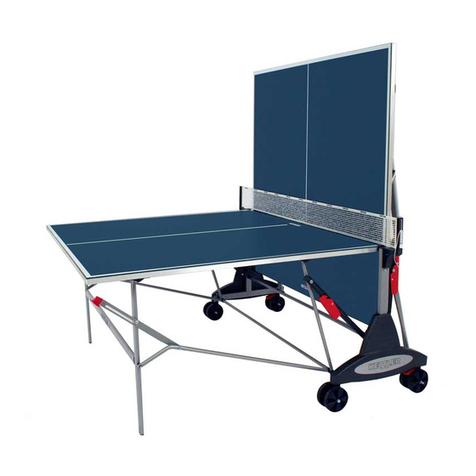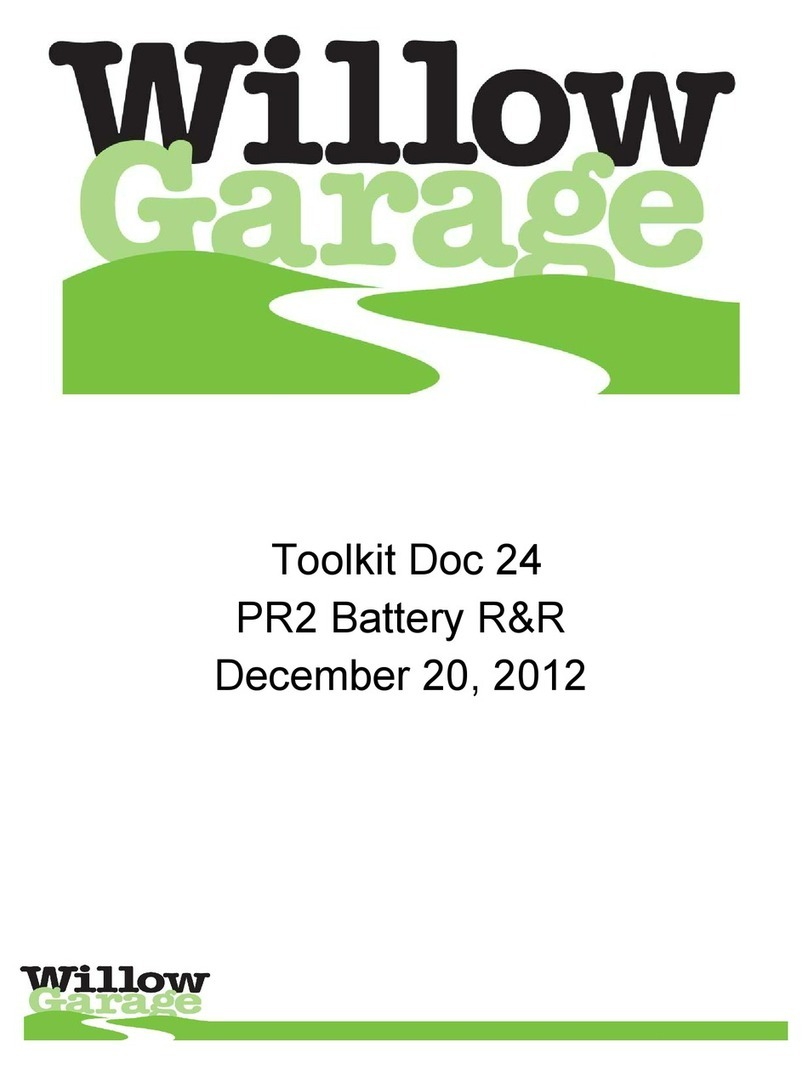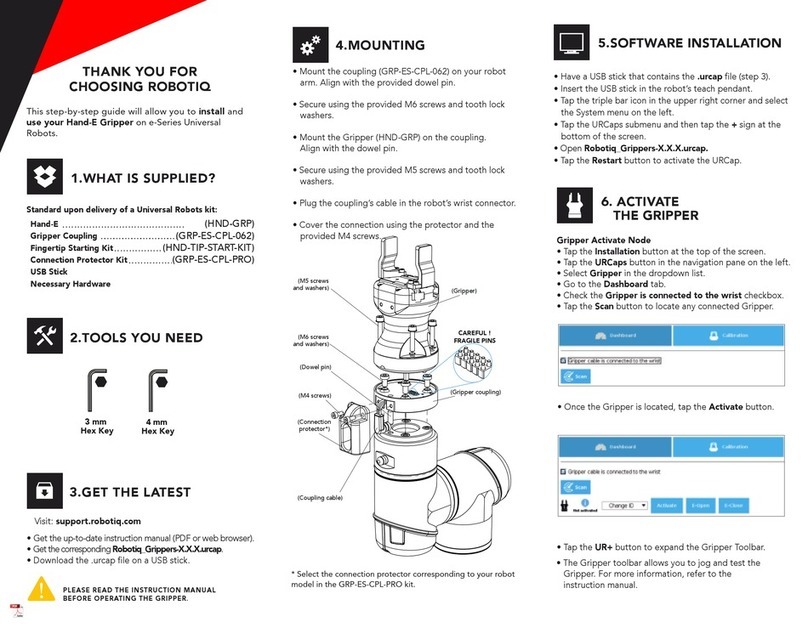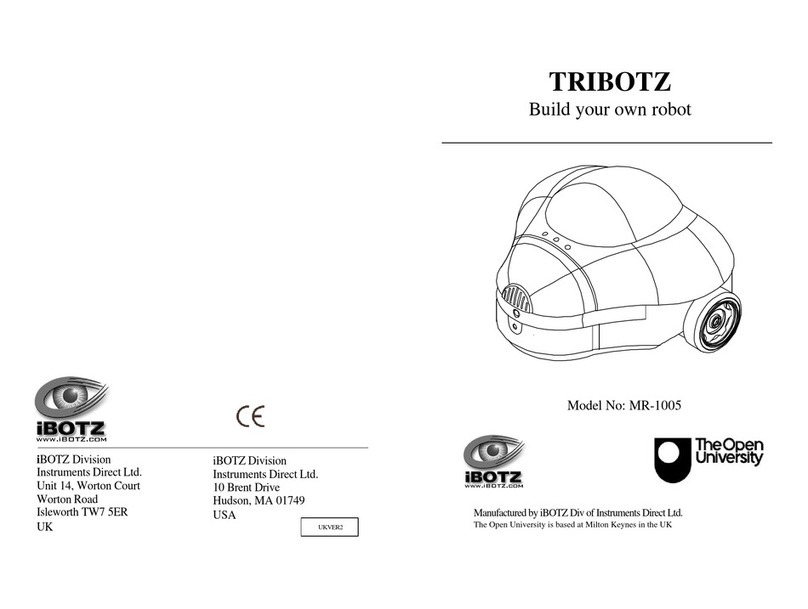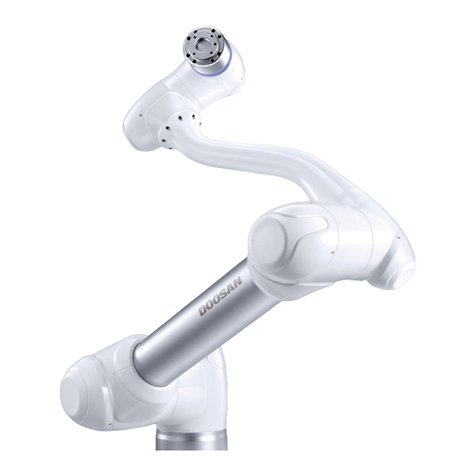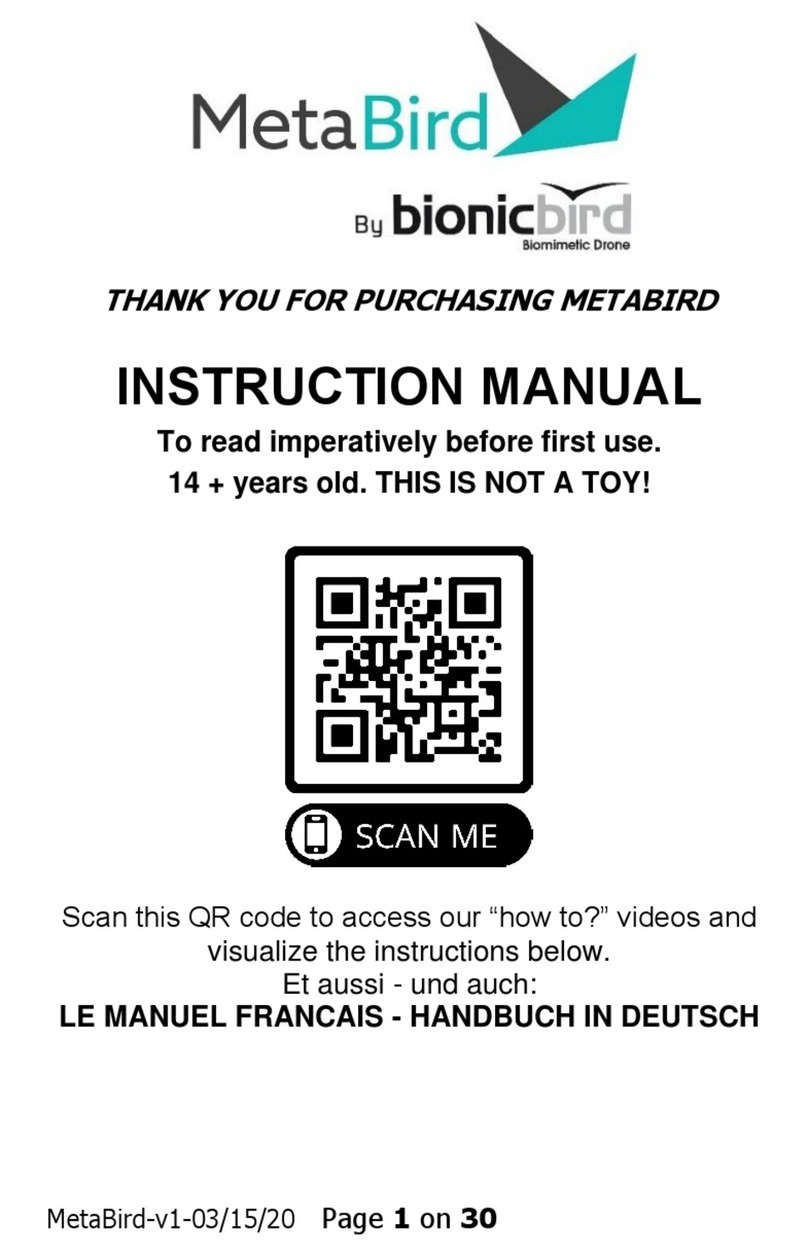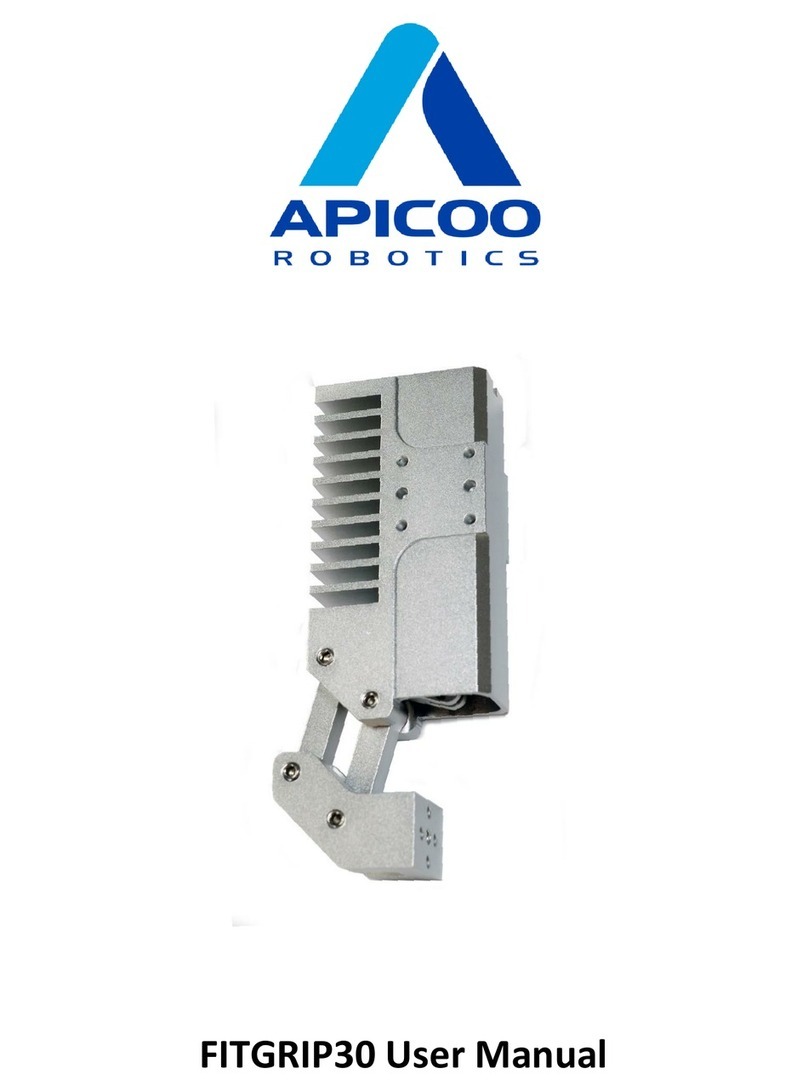be bionic steeper User manual

Technical Manual
small

2

3
Contents
1.0 Introduction 04-05
1.1 In the Case
1.2 Principal Dimensions and Specifications
2.0 bebionic Grips 06-11
2.1 Factory Settings
2.2 Program Switch
2.3 Thumb Adjustment
2.4 Opposed Grips
2.5 Non-Opposed Grips
3.0 bebionic Glove 13-15
3.1 Care Instructions for bebionic Glove
3.2 How to fit a bebionic Glove
3.3 Removing a bebionic Glove
4.0 Connections & Compatibility 17-21
4.1 Wrist Options
4.2 Battery Options
4.3 Power Information
4.4 System Connections
4.5 System Compatibility
5.0 bebalance 23-31
5.1 Introduction
5.2 Installation
5.3 Start Up
5.4 Language Selection
5.5 Enabling bluetooth (BT) Connection
5.6 Operating Modes
5.7 Hand Configuration Introduction
5.8 Grip Selection
5.9 Advanced Features
6.0 Additional Information, Warranty, Repairs and Returns 33-43
6.1 Repairs
6.2 Quality Assurance
6.3 Warranty
6.4 Returns

4
1.0 Introduction
This document contains important information for the correct use and set up of the bebionic small hand. Read this
document thoroughly before fitting a bebionic small hand.
A bebionic system is completed by adding from a selection of compatible system components including electrodes
(or other input devices), battery systems, wrists and cables. We recommend Steeper / SteeperUSA components.
The bebionic small hand is designed for mild to moderate activities. Avoid use in situations with heavy loads, vibrations
or impacts.
Key:
1.
5.
3. 2.
1. bebalanceBT bluetooth dongle
2. bebionic small hand
3. bebionic small tool kit
4. bebionic small user guide
5. bebionic small technical manual
6. bebalanceBT software CD
7. spare palp box
4.
6.
7.
1.1 In the case
Text with this symbol contain important
safety information.
WARNING
!
CAUTION
Text with this symbol highlights potential sources
of damage to the hand.
The bebionic hand contains Electrostatic Sensitive
Devices. Any disassembly on this hand must be
carried out by Steeper authorised personnel in an
Electrostatic Protected Area (EPA). Failure to do
this could cause ESD damage which will aect
the reliability of the product and could impact
product warranty.
WARNING
We do not recommend the use of carbon fibre
materials in fabricating a prosthetic arm due
to electrical conductivity. If however it is used
then it is important to ground the carbon fibre
lamination.
WARNING

5
B
D
A
C
Principal Dimensions Small
A middle finger tip to hand base 6 1⁄2” (165mm)
B thumb tip to hand base 4 1⁄8” (105mm)
C max chassis width (no glove) 2 7⁄8” (72mm)
D diameter of chassis at wrist 1 3⁄4” (45mm)
palm circumference (no glove) 7” (179mm)
maximum opening width - tripod grip 3 1⁄2” (90mm)
thumb swing through angle 68o
X EQD only 1⁄4” (2mm)
†Build height comprises of thumb tip to base of hand measurement, followed by the build height for each wrist option.
The second number refers to the minimum allowance for the mating wrist unit.
*Denotes side of hand, Insert L for a left hand, or R for a right hand.
Part Number Build Height †Weight Description
BBHSM*QD-W 4 1/8” + 1” (105mm + 25mm) 13 3⁄4 oz (390g) bebionic small hand with EQD Wrist - white
BBHSM*SW-W 4 1/8” + 1/2” (105mm + 12mm) 13oz (369g) bebionic small hand with Short Wrist - white
BBHSM*QD-W-F 4 1/8” + 2” (105mm + 53mm) 16oz (460g) bebionic small hand with Flex Wrist - white
BBHSM*QD-B 4 1/8” + 1” (105mm + 25mm) 13 3⁄4 oz (390g) bebionic small hand with EQD Wrist - black
BBHSM*SW-B 4 1/8” + 1/2” (105mm + 12mm) 13oz (369g) bebionic small hand with Short Wrist - black
BBHSM*QD-B-F 4 1/8” + 2” (105mm + 53mm) 16oz (460g) bebionic small hand with Flex Wrist - black
Small
maximum power grip force 140.1N
maximum tripod grip force 36.6N
maximum key grip force 26.5N
maximum time to open or close - tripod grip 1.0 seconds
maximum time to open or close - power grip 0.5 seconds
maximum time to open or close - key grip 1.0 seconds
maximum static load - hook grip 99lb 3oz (45kg)
maximum load individual finger - hook grip 55lb 2oz (25kg)
maximum finger tip extension load 13lb 3oz (6kg)
maximum safe vertical load taken through knuckles 198lb 6oz (90kg)
X
X
1.2 Principal Dimensions and
Specifications

6
The bebionic small hand provides 14 dierent grip patterns, allowing the user to have a more complete device to
assist them in their day to day life. The hand has two selectable thumb positions: opposed and
non-opposed.
Opposed places the thumb in opposition to the fingers on the hand, allowing grips like Tripod and Power.
Non-Opposed places the thumb parallel with the fingers of the hand and allows grips like Key and Finger Point.
Opposed Non-Opposed
2.0 bebionic Grips
The hand is supplied preset in Mode 4. This provides two
input operation with proportional control of grip and
speed. Speed and grip force are set to maximum.
To alternate between the default and alternative grip
pattern, an OPEN OPEN signal must be applied (i.e. the
hand must be fully opened, the signal relaxed and then a
second open signal supplied). To alternate between the
primary grip pattern table and secondary grip pattern
table, press the Program Switch for less than two seconds.
The Auto Grip feature is turned o.
Primary Opposed
Default - Tripod
Alternative - Power
Primary Non-Opposed
Default - Key
Alternative - Finger Point
Secondary Opposed
Default - Active Index
Alternative - Tripod
Secondary Non-Opposed
Default - Column
Alternative - Mouse
Factory setting grips -
if your hand has been reprogrammed prior to delivery
individual settings will vary.
2.1 Factory Settings

7
A Program Switch is provided on the back of the hand. This has four functions;
1. Switch the hand ON and OFF
A single press for approximately three seconds will switch the hand OFF. A single
press for more than two seconds will switch the hand ON.
2. Alternate between the primary and secondary grip patterns
When the hand is switched ON, a single press of less than two seconds will alternate
between the primary and secondary grip patterns. This will be accompanied by a short
bleep and vibration (if activated on bebalance).
3. Enable / disable the in-hand bluetooth module
With the hand switched ON, a single press for more than six seconds will enable the bluetooth module. A double
beep/vibrate will indicate connection has been made. Pressing the switch again for more than two seconds or
disconnecting the power to the hand will disable the bluetooth module.
4. Enter / exit glove mode as follows
With the hand switched OFF, press the switch until the thumb begins to drive in. Then release the switch. For
more information please see page 20.
2.31. Thumb ML Adjuster
2.32. Thumb Contact Point Adjuster
An adjuster has also been provided to alter the baseline position of the thumb, in order to optimize the contact
point of the thumb tip against the opposing finger(s) for Tripod, Pinch and Precision Grips. This is done by
moving the thumb either towards the palm or away from the palm. This adjuster is located under the thumb
bracket as shown above. Using a hex drive the adjuster should be turned clockwise to move the thumb towards
the palm and counterclockwise to move the thumb away from the palm. The eect will not be observed while
making the adjustment and can only be observed by resetting the hand i.e. switching the hand OFF and ON
again.
An adjuster is provided to allow repositioning of the thumb for contact with either the index and middle fingers,
as in Tripod Grip, or with index finger only, as in Pinch and Precision Grips. The thumb pivot assembly is fitted
with a hex screw as shown above. This acts to adjust the endstop of the thumb when in the opposed position.
To adjust the position of the thumb, first loosen the adjustment screw to allow free rotation of the thumb.
Reposition the thumb to the optimum tripod or pinch position, and retighten the adjustment screw to set the
new position.
Thumb adjustment MUST be completed
by a qualified technician or practitioner
CAUTION
!
2.2 Program Switch
2.3 Thumb Adjustment
To achieve certain grips it is necessary to adjust the thumb position.
There are two dierent planes to move the thumb in,
as detailed below.

8
Power
With the thumb opposed, all four fingers close into the palm
until they meet resistance or the close signal stops. When
fingers are approaching a fully closed position, the thumb drives
in to cover the fingers for additional grip security. This pattern
allows round objects such as a ball or a piece of fruit to be held
securely. This grip can also provide a handshake. Cylindrical
shaped objects such as bottles, home and garden utensil
handles are also held easily and securely.
Tripod
When the thumb is opposed, the hand closes into Tripod Grip
with index and middle fingers meeting the thumb. Ring and little
fingers continue to close until they meet resistance or the close
signal stops. This type of grip allows users to pick up, hold and
manipulate a variety of everyday objects such as car keys, coins,
jar lids and pens.
Hook
With the thumb in opposed position, a partially closed Power
Grip provides Hook Grip. This is ideal for carrying a shopping
bag or briefcase. Hook Grip can also be achieved by closing the
fingers from the relaxed hand position.
Finger Adduction
The fingers of the bebionic hand move together naturally as the
fingers close. This allows the user to securely grip thin objects,
such as cutlery or a toothbrush, between the fingers to achieve
function in a dierent plane. Finger Adduction is most functional
with the hand in Power Grip but can also be achieved with the
hand in Key Grip and Pinch Grip.
Grips
2.4 Opposed - Thumb in opposition to the fingers

9
Active Index
With the thumb opposed Active Index Grip will grasp the handle
of an object with the middle, ring and little fingers and secure the
grip with the thumb. The index finger will then close – this may be
positioned over the lever of the device held such as a spray bottle,
it also offers the ideal finger position for typing. The index finger is
under independent user control and may be positioned accordingly.
To exit Active Index, an open signal will fully open the index finger
before the other fingers and thumb release their grip.
Precision Closed
This grip can be used in situations similar to the Precision Open
Grip, but where extended fingers would be obstructive, such as
working at a desk. Initially the middle, ring and little fingers close
into the palm. The thumb moves to the midpoint of its range and
pauses. The Index is then active and under user control.
(To achieve this grip it is necessary for the thumb to be manually
repositioned by the practitioner/technician so that the thumb only
contacts the index finger.)
Precision Open
With the thumb opposed, the index finger meets the static thumb
allowing the user to pick up and manipulate small objects. When
this grip is selected and a close signal is applied, the thumb closes
to the midpoint of its range and pauses. The index is then active
and under user control. The middle, ring and little fingers remain
extended. (To achieve this grip it is necessary for the thumb to be
manually repositioned by the practitioner/technician so that the
thumb only contacts the index finger.)
Pinch
The thumb only contacts index finger and is used for the fine
manipulation of objects. To achieve this grip it is necessary for the
thumb to be manually repositioned by the practitioner/technician
so that the thumb only contacts the index finger (See section 2.3).
The bebionic hand MUST NOT be used to operate a firearm
SERIOUS WARNING

10
Finger Point
With the thumb in the non-opposed setting, the user can move
to Finger Point position. The middle, ring, and little fingers
close against the palm and the thumb moves against the
middle finger. With this grip, typing on a keyboard or input pad,
pressing a bell or a button can be achieved.
Key
In the non-opposed thumb position, the four fingers partially
close. The thumb then closes onto the side of the index finger.
The thumb position may be raised and lowered without moving
the other four fingers allowing for release, capture or reposition
of the object being gripped. This pattern is ideal for carrying
paper or letters, using a spoon and for holding a thin flat object
such as a plate, a credit card or a key.
Grips
2.5 Non-Opposed - Thumb is parallel with the fingers
Open Palm
With the thumb in the non-opposed position the hand may be
fully opened to provide a flat palm suitable for carrying a tray or
a plate.

11
Relaxed Hand
The thumb is set to the non-opposed position and partially driven
in toward the palm. All the fingers are driven to a slightly flexed
position.
Applying a further signal will drive the fingers into Hook Grip for a
carrying position.
Mouse
The thumb and little finger close to hold the side of the mouse,
with the middle and ring fingers providing stability. The index
finger closes on to the mouse button and then backs o to
provide the button press. Each close signal will give a mouse
click whilst an open signal will release the mouse.
Column
This grip moves the thumb into the palm from a non-opposed
position. The fingers then close over the thumb to provide
a fixed column that can be used as a way to push heavier
objects or larger buttons and switches. Column is also the
recommended grip for dressing, as the thumb is kept out of the
way.

12

13
The bebionic glove is made from a multi-layered, variable hardness, silicone-based material, lined with fabric mesh.
This construction resists soiling, wear and puncture damage.
bebionic gloves provide high compliance with gripped objects. The fabric liner allows the glove to slide over the
joints during motion, this reduces the amount of power need to drive the hand and conserves battery life.
The standard glove is supplied in 19 skin tones and in a solid black color. bebionic gloves provide an additional
barrier to dirt, dust and moisture ingress to the hand. Direct exposure to water, or situations where dirt and dust
are prevalent should be avoided as these have the potential to interfere with or damage the hands performance.
The bebionic glove has been designed
specifically for use with the bebionic
hand. The use of other gloves may
damage the hand and will void the
warranty.
CAUTION
!
3.0 bebionic Glove
Care
Take care when fitting and using the bebionic glove. Try to
avoid contact with sharp or pointed objects.
High Definition Nails
Silicone gloves have nails painted by hand following the
manufacturing process.
We do not recommend the use of polystyrene nails attached
with Cyano-acrylic glue as attempts to remove the nails
bonded with this adhesive will permanently damage the
glove.
Cleaning
General soiling can be removed with soap and water. After
cleaning remove all traces of the cleaner and wipe the
surface dry. Most dyes will be fully removed by this process.
A liquid domestic fabric softener can be diluted to reduce
the ‘tackiness’ of the surface. The material used will resist
most staining media.
For any other enquiries please contact your local supplier.
3.1 Care Instructions

14
1. 2. Switch the hand OFF by pressing down the
program switch on the back of the hand for
approximately three seconds.
Move the thumb into the opposed
position.
Do not attempt to fit the glove unless
the hand is in glove donning mode.
CAUTION
!
Do not use talcum powder or lubricant
when fitting the glove
CAUTION
!
3. 4.Press and hold the program switch for six
seconds. The hand will automatically drive into
glove mode.
The thumb will be in the position shown above
when the hand is in glove mode.
bebionic Glove
3.2 Fitting the bebionic glove
5. Fold up the base of the glove. 6. Pull the glove over the hand

15
7. 8.Ensure the fingers and thumb of the hand
align correctly with the fingers and thumb of
the glove.
Hold down the program switch for four sec-
onds to exit glove donning mode and begin
using the hand.
3.3 Removing the bebionic glove
1. 2.
3. 4.
Firstly oppose the thumb. Then turn the hand
OFF by pressing the program switch for ap-
proximately three seconds. Next put the hand
into glove donning mode by pressing the pro-
gram switch for 4 seconds.
Roll up the base of the glove and pull the
whole glove o from the back of the hand.
Do not pull the fingers individually as this can
damage the glove and the hand.
Exit glove donning mode by pressing and
holding the program switch for four seconds,
the hand will automatically drive out of
glove donning mode and will be active in the
default grip.

16

17
A bebionic system is very versatile and allows a number of dierent power and connectivity options.
Most options are detailed in the following section of this document. However if you have a question regarding a
specific build not outlined in this document please contact your local supplier.
The bebionic hand may also be used with other manufacturers’ electrodes and wrists. This means the bebionic
small hand can be fitted into an existing system without having to change every single component.
4.0 Connections and Compatability
4.1 Wrist Options
Thee are currently three wrist options for the bebionic small hand.
Electric Quick
Disconnect (EQD)
Short Wrist
Allows the hand to be removed
with a rotating action. The EQD
wrist allows the patient to quickly
rotate and remove or attach
terminal devices as required.
Low profile connector for
applications where there is a
long residual limb. A short wrist
lamination assembly is supplied
attached to these hands. The hand
can be rotated against a constant
friction, which can be adjusted by
the patient.
Flexion Wrist
The Flexion Wrist from Motion
Control is a simple flexion device
that allows the wearer to easily
lock or unlock the wrist position
and reposition the wrist in either a
flexion or extension position. The
mechanism allows the wrist to be
flexed or extended to 30 degrees
in either direction and locked in
each of the three positions.
4.2 Battery Options
BBI=1300S
Typical Capacity: 1300mAh
Voltage (Nominal): 7.4V
Size: 8.6 x 36.5 x 66.5 mm (x2)
(3⁄4” x 1 3⁄8” x 2 5⁄8”)
BBI=2200S
Supplied with a removable shrink
fit coating, allowing the cells to be
split for easier fitting in the prosthesis.
Typical Capacity: 2200mAh
Voltage (Nominal): 7.4V
Size: 18.5 x 36.5 x 70 mm
(3⁄4” x 3⁄4” x 2 3⁄4”)
or 18.5 x 18.5 x 70 mm (x2 when split)
(3⁄4” x 1 3⁄8” x 2 3⁄4”)
Only the following battery options should be used with the bebionic
small. Use of other battery systems is not recommended.
WARNING

18
When the battery capacity approaches its lower limit the hand operation will slow down and begin to respond only to
OPEN signals. This occurs to ensure the hand stops in an open position to prevent the hand becoming locked onto an
object when the power has been completely drained from the battery. The battery must be recharged for further use.
Low Power Condition
A bebionic hand uses five actuators and therefore requires a higher current supply than single motor devices. This
can be accommodated safely using bebionic power cables. Other power cable types may not be ecient or safe.
However, cables from other manufacturers may be adequate for signaling application.
Power Cables
An ON/OFF switch is integrated into the charge module. The switch
disconnects power completely, and has two positions. When the switch is
positioned closest to the charge port, power is OFF and the battery can be
charged by connecting the lead from the bebionic charger. When the switch
is furthest away from the charge point, power is switched ON. The battery
cannot be charged in this position.
The ON/OFF switch / charge module is fitted to the battery and requires an
additional connector cable to link to the hand.
The connector cable for EQD hands, as shown on page 28, is supplied with
each battery. For short wrist or friction wrist options a dierent connector
cable (CBBHA72), as shown on page 29, will need to be ordered separately
and connected to the battery pack in place of the EQD connector cable.
A small laminating dummy is included in the kit. Prior to lamination this should be placed in a suitable location and
orientation on the forearm model. The position chosen should allow sucient space between the inner and outer
sockets to allow easy access to the switch and plug point by the user.
Battery Switch / Charging Module
It is NOT recommended to route the power
supply to the hand without passing through the
switch.
WARNING
System cables MUST NOT be cut while power
is ON. This will short the battery and damage
the system. Any damage caused in this way will
void the bebionic
warranty.
WARNING
The prosthesis MUST NOT be worn whilst the
batteries are charging.
WARNING
When attaching or detaching a bebionic hand
to/from a prosthesis, it is important to first
disconnect power by moving the battery switch to
the OFF position.
This is to avoid a potential current surge to the
hand when it connects/disconnects with the
power source.
CAUTION
!
4.3 Power Information

19
4.4 System Connections
Please note: Part B27804 is supplied with each battery pack and will not need to be ordered
separately.
Components not to scale.
The system detailed below is suitable for a bebionic
hand with an
Electronic Quick Disconnect and Flex Wrist
BBI=1300S
bebionic 7.4V
1300mAh split
cell battery
BBI=2200S
bebionic 7.4V
2200mAh split or
single cell battery
B27804
battery switch and
charge point with cable.
ELEC50/ELEC60
2 x Electrode 50Hz or 60Hz
QDACO
co-axial plug

20
Please note: Part B27804 is supplied with each battery pack and will not need to be ordered
separately, however part CBBHA72 will need to be ordered separately for hands with Short
Wrist.
Components not to scale.
The system detailed below is suitable for a bebionic
hand with a
Short Wrist
CBBHA72
connector cable
BBI=1300S
bebionic 7.4V
1300mAh split
cell battery
BBI=2200S
bebionic 7.4V
2200mAh split or
single cell battery
B27804
battery switch and
charge point with cable.
ELEC50/ELEC60
2 x Electrode 50Hz or 60Hz
Table of contents
Popular Robotics manuals by other brands
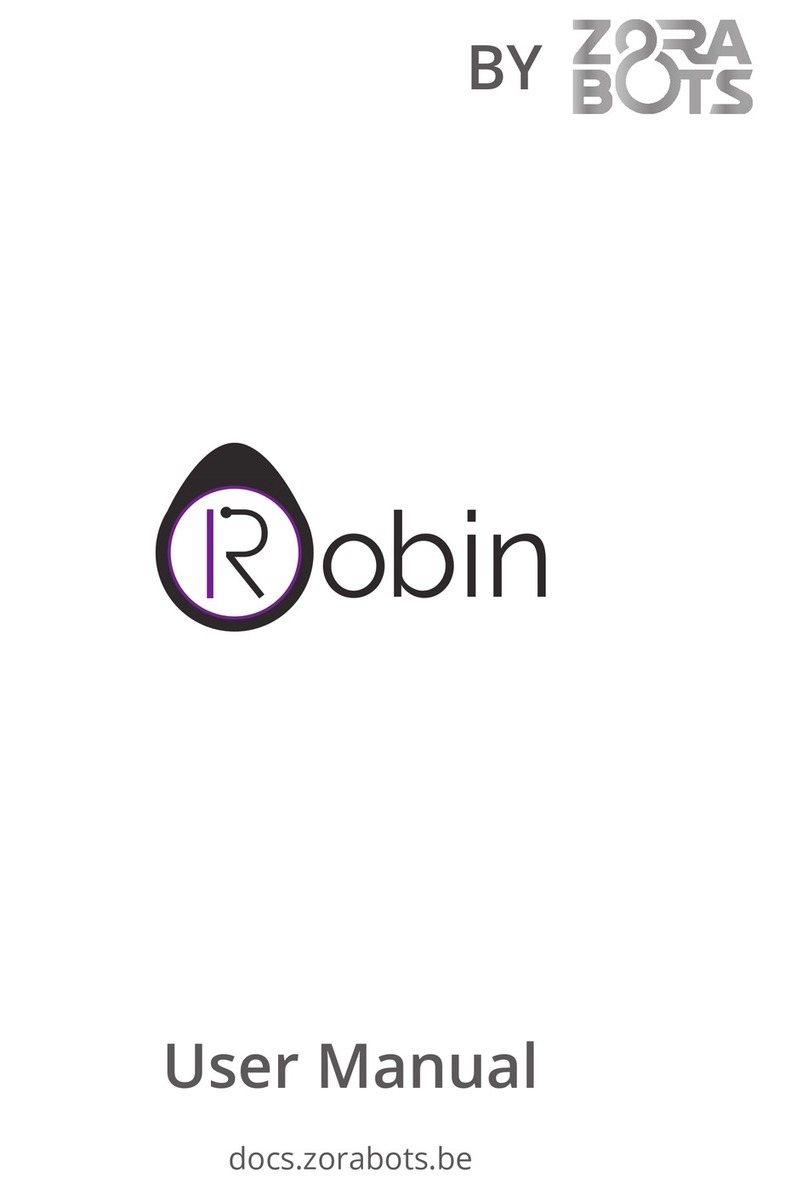
ZoraBots
ZoraBots Robin user manual
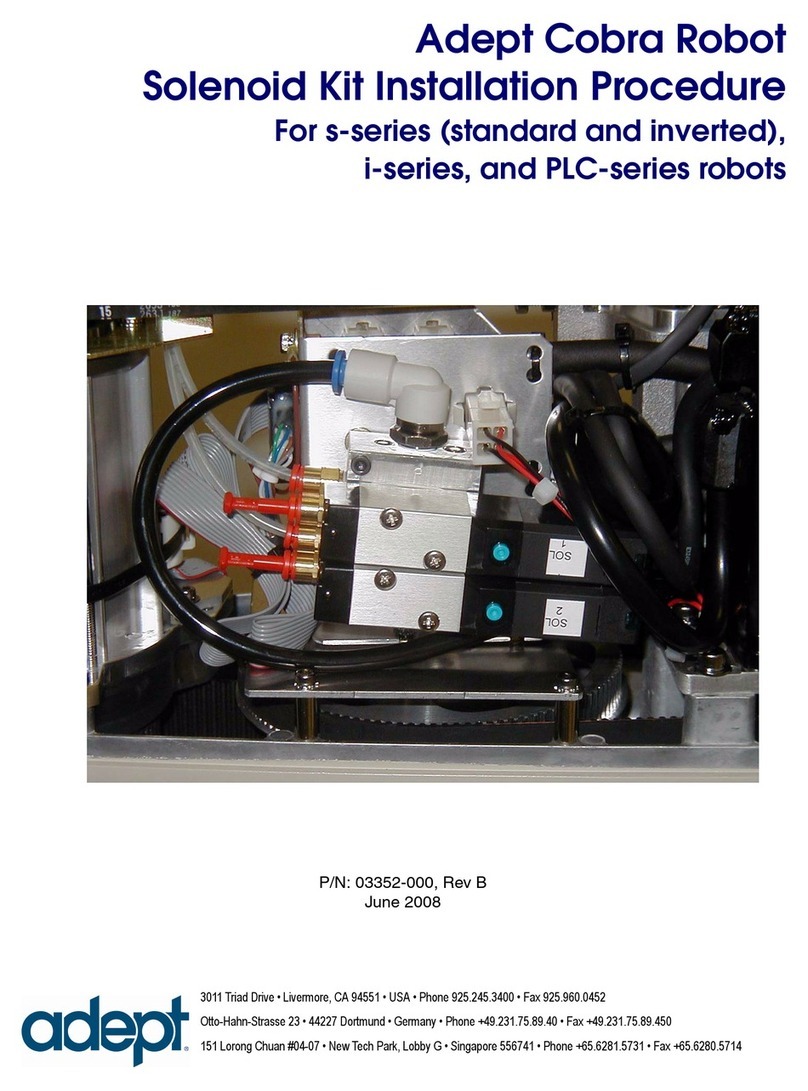
adept technology
adept technology Cobra 03352-000 Installation procedures
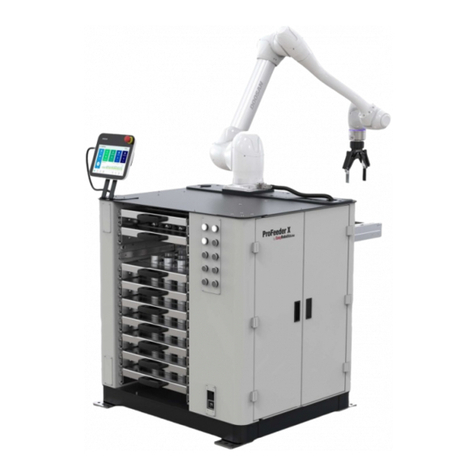
EasyRobotics
EasyRobotics PROFEEDER X user manual
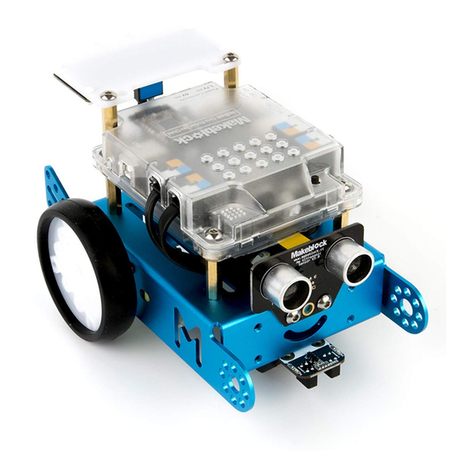
Makeblock
Makeblock Explorer quick start guide
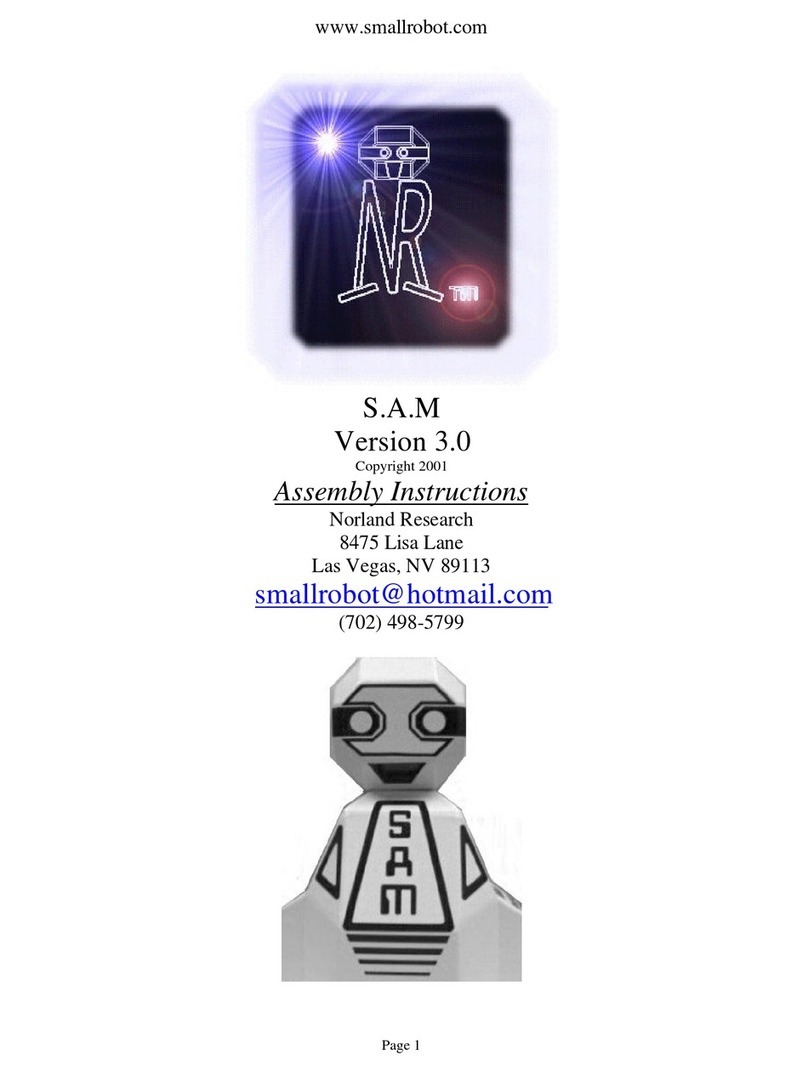
Norland Research
Norland Research S.A.M Version 3.0 Assembly instructions
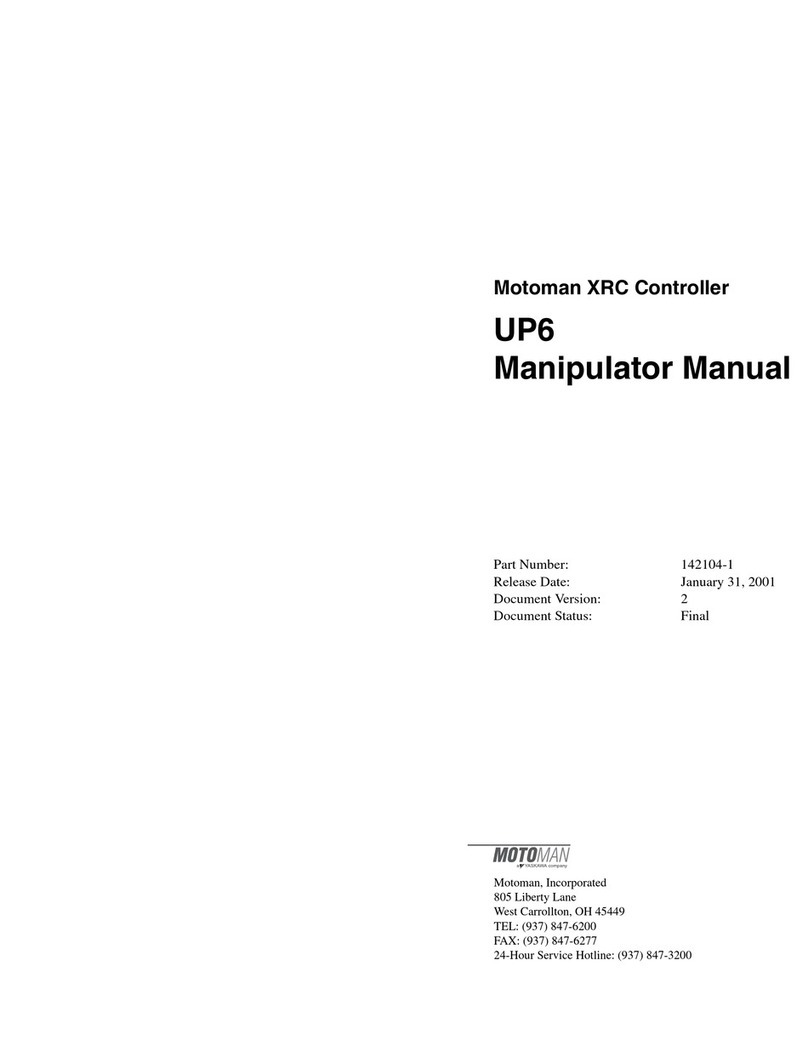
YASKAWA
YASKAWA Motoman UP6 instructions

